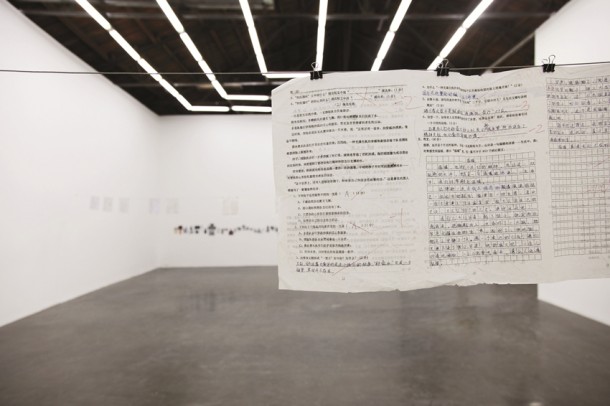SONG TA:THE LOVELIEST GUY
| 2015年01月21日 | 发表于 LEAP 30

Paper, found objects, dimensions variable. Courtesy of Beijing Commune
BEIJING COMMUNE
2014.09.30 – 2014.11.15
Song Ta’s exhibition at Beijing Commune is unusual in that the work he includes does not make use of a common visual language, nor does it have a clear conceptual focus. In the absence of these two factors—critical to most contemporary art discourse—viewers can be left dumbfounded. Which is also to say, liberating viewers from weighty artistic discourse can make it easier for us to appreciate the light humor and mild political tone of his work.
The show consists of just three works. For These Are Your Test Scores, and You’re Still Playing Around? Song Ta collects 30 student test papers with grades of 59.5% and hangs them on a clothesline in the larger of the two exhibition spaces. On the facing wall is People Who Write Like Me, which consists of 30 samples of “calligraphy” resembling the artist’s own handwriting, all gathered from the internet and other sources around him. Neither the test papers nor the handwriting samples are of interest in and of themselves; they are jokes that come off a little too serious. He hints gently at testing boundaries, including the institutional and commercial definitions of art. Song includes political discourses and symbols in his work in order to draw attention to viewers’ understandings of political thought and aesthetic standards.
Song Ta has maintained this tone since his first solo exhibition, “Gray Area,” at Guangzhou’s Observation Society in 2011. In the video Children, shown there, Song asks friends to play the roles of parents whose child is lost; they make announcements over the loudspeakers of a zoo using the names of Guangdong Province Communist Party Standing Committee members. Functioning as a practical joke, the work gently satirizes the political discourse of official news channels. In Gray Area, Song finds a space to test the cracks of power, then executes: he persuades a local official to test the generally ignored rule that men in public office must not grow facial hair by letting his mustache grow until his bosses told him to shave it off. The exhibited work consists of before-and-after shots.
Between “Gray Area” in 2011 and “The Loveliest Guy” in 2014, Song Ta’s practice has taken him to museums, art fairs, nonprofit spaces, and commercial galleries, but most of his public exhibitions pale in comparison to projects that circulate by word of mouth; more often than not his art is completed when someone else declares it to be so. The title piece, Who Is The Loveliest Guy, is a three-channel looping video of a group of uniformed sailors in the Chinese navy on a roller coaster. Looking for the man the artist labels “loveliest,” we end up with nothing—or just suppress a smile. The greater challenge lies in figuring out how to respond to the artist’s tests.(Translated By Van¬essa Nolan)

